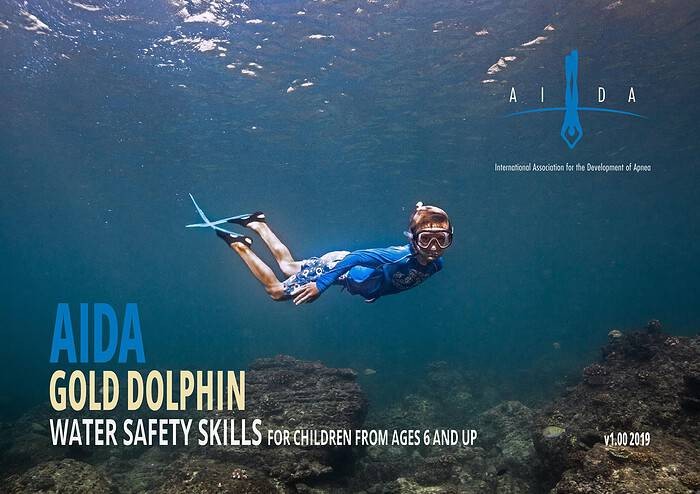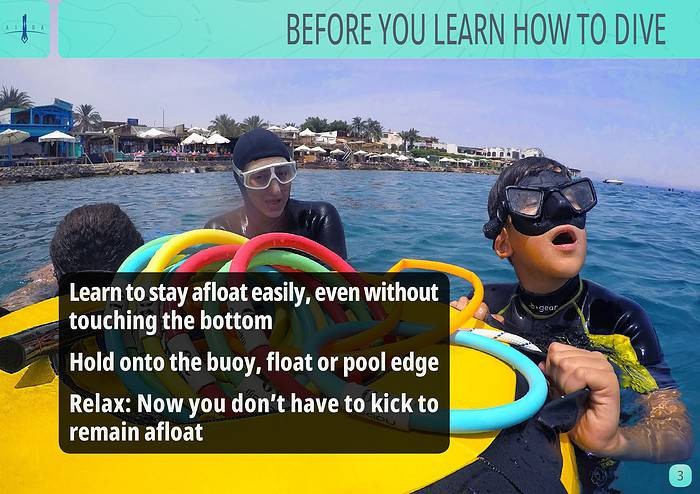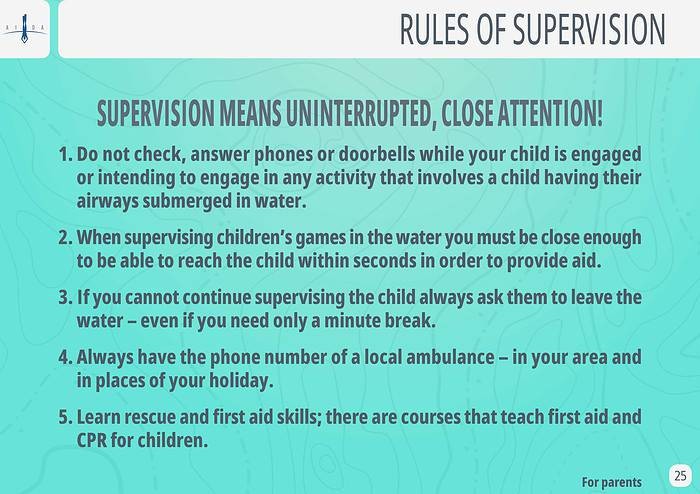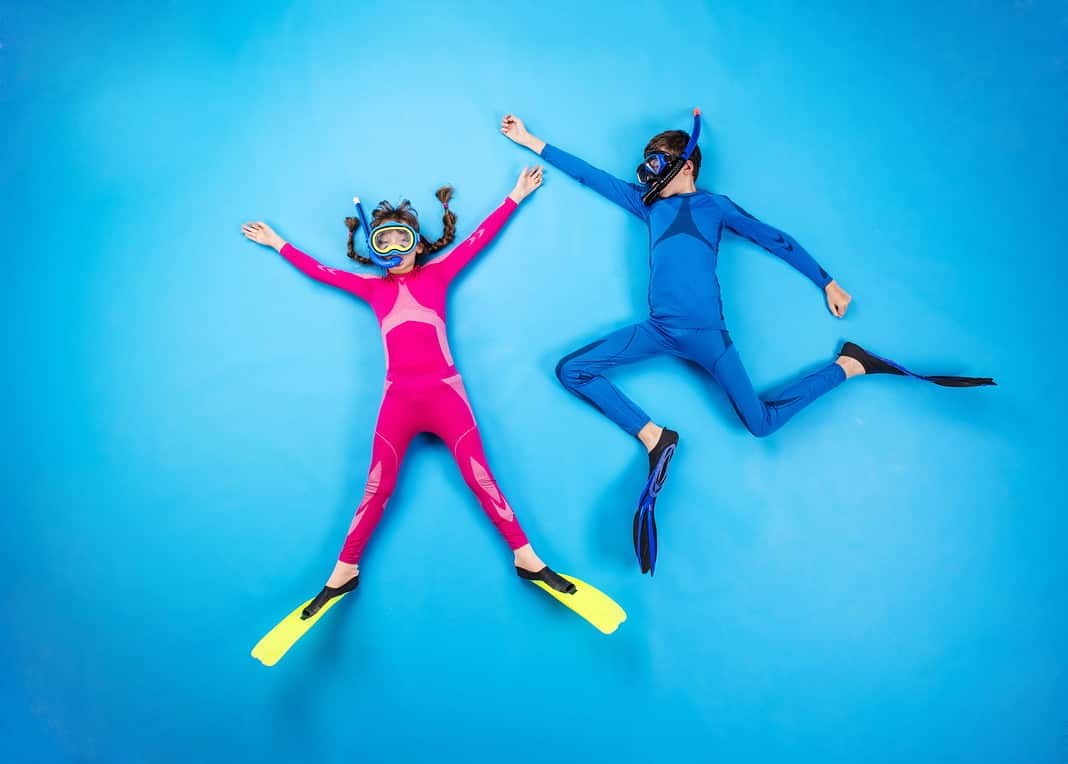In May, AIDA released the AIDA Youth Programme, a program that aims at teaching water and safety skills to children and adolescents. The program was developed by the AIDA Education Committee with the help of the Medical Committee, the newly established Youth Commission, and AIDA instructors from around the world.
The AIDA Youth Programme consists of four courses — Bronze Dolphin, Silver Dolphin, Gold Dolphin, (6 to 11 years), and AIDA Junior (12 to 15 years). Each Dolphin course takes at least three days, whereas AIDA Junior takes at least four days.

The courses aim to teach children in-water confidence and develop diving skills, such as breath and buoyancy control, duck diving, and finning. The core approach to the design of the programme lies in conservatism, with an emphasis on parental education and performance-oriented skills. The courses have been thoughtfully designed to develop competence and confidence, following a natural and individual progression rate. One of the prerequisites for all courses in the programme is the child’s own wish and intent to learn water skills. The courses are skill-oriented, and do not have any performance requirements; on the contrary, a maximum performance limitation is recommended for each course, as advised by the AIDA Medical Committee.
The minds behind the AIDA Youth Programme include members of AIDA France and the AIDA Education Committee, the Medical Committee, the Youth Commission—which was organized specifically to supervise all the work on the program, a legal expert, and a sport psychologist. Many experienced AIDA instructors donated their ideas of in-water exercises and games; the 30 contributors are listed in the credits of the AIDA Youth materials.
The Youth Programme has been in development for quite some time — Elena Petrushina, the leading author, started working on the programme in 2018, after realizing the growing demand and need for a more formalized and well-researched water education for children. Rémy Dubern, Benoît Canell, Rémi Berezay, and Claude Chapuis from AIDA France realized the very beginning of the project, having proposed the first initiative for teaching children in 2017 in the shape of a document that would later become the foundation for the current Youth Programme. The Medical and Science Committee played an important role as well, creating a solid scientific basis for the programme. For the creation of the Youth Programme, AIDA elected three members, two physicians, and a physiologist, and was advised by a medical expert panel of 20 leading international scientists and physicians.

A large part of the work in crafting the courses comes from the fact that children and adults have to be taught differently. The Medical Committee has had to consider anatomical, physiological, and mental differences when writing up the guidelines. For example, a child’s lung volume and cardiovascular system are not completely formed, and young children also have other stressors and fears than adults. Therefore, a conservative approach was paramount in the development of all aspects of the programme. A conservative approach minimizes the risk of anything happening to the children, as, according to the head of the AIDA Medical Committee, Oleg Melikhov, “the physiological consequences of freediving, such as undertaking physical exercise under hypoxic conditions, are not known in their full extent — even for adults”. The age limits and water sessions regime were in large decided on as the tolerance of physiological and neurological stress differs between different age groups.
Including and educating the parents or guardians of the children is another fundamental part of the Youth Programme. Teaching proper adult supervision ensures that the children will become safer water users through these courses. Elena Petrushina had her very own ‘aha’ moment when working on the programme: she realized how reckless and inattentive people can sometimes be, and, “that even if we might find current parents as being overly protective, they cannot be in the case of water activities”.
Therefore, the programme sees the education of parents as equally important to the education of children in the water, because any water activity should always be supervised. Once the course is over, the children need proper safety measures in place to continue developing the skills taught during the course. “Only informed adults can properly advise children”, Petrushina states and this “requires a lot of attention, patience, and gentleness”. Compassion, understanding, care, and connection is equally important, according to Petrushina, and these values have informed the way the course material is delivered to the children and parents.

For example, a child is taught to never dive without an adult present. Adults are taught to always supervise children with uninterrupted close attention, they are advised to take a first aid course, to learn rescue skills, and know the full numbers of local emergency services at their holiday location. A parent with freediving skills can supervise a child in a body of water deeper than 2 m, but if the adult does not have any freediving skills, they should not let their child in water deeper than 2 m without an adult freediver present.
The programme turns away from a training-centered approach and instead adopts a skill-oriented approach. This is reflected in both the way the sessions are structured, but also in the language used in the courses. AIDA Youth is not teaching ‘freediving’; it teaches ‘water and safety skills’. Neither the concept of ‘breath-holding’ or ‘contractions’ is referred to in the material. Children learn ‘breath control’, which implies that they know to inhale when above the surface, hold when submerged, and surface if they feel the ‘the urge to breathe’. Children are encouraged to safely progress at their own pace. By removing terms that can be measured by performance and lead to competitiveness (e.g., ’breath-hold’, indicating that there is a duration), instructors can instead focus on the learning experience of the child.
The Bronze Dolphin course will, for example, teach children how to float, swim on the surface and underwater with fins, enter and exit deep water, how to use, maintain, and store gear (mask, snorkel, wetsuit, fins), how to perform the survival stroke, tread water and call for help. The classroom sessions will introduce the children to various other safety skills, such as the ‘Tik Tok’ sign, or the arm wave, which is the internationally recognized sign for help in the water. Diving on a line and equalizing is introduced in the Silver Dolphin course, and the Gold Dolphin course will see children both pulling and finning down the line. The AIDA Junior programme essentially contains all the material from the Dolphin courses and is the last programme for children before they are old enough to enroll in the adult AIDA courses. The course introduces some terms omitted from the Dolphin courses, such as ‘buoyancy’. None of the programmes teach static, and each course has a recommended maximum performance limit.
Any active AIDA instructor holding a current first aid certificate that covers first aid for children (or AIDA FEMR) can enroll online to become an AIDA Youth Instructor. The whole course takes place online and is finished by completing the exams. In the first month, more than 140 instructors enrolled on the Youth Instructor course, and more than 50 candidates completed their exams and gained AIDA Youth Instructor status.
For the newly certified Youth Instructors, there is plenty of guidance in the material for preparation, execution, and problem solving during the courses. For example, the Youth Instructors Manual addresses the psycho-pedagogical aspects of teaching children of different ages, how to create a good learning environment, and introduces different approaches to teaching a skill. The courses have all been trialed by the members of the Youth Commission with great results, and are now ready to be launched out into the rest of the world.
By introducing quality control of youth education, AIDA has taken charge of the development of water education offered to children, paving the road for children’s enjoyment of the water and providing instructors with a well-researched set of guidelines and standards to follow. The programme hopes to guide the young water-lovers and budding freedivers safely in their early years of exploring the waters of the world, giving them a solid foundation whether they choose to pursue freediving as adults or simply want more confidence in the water.
Article by Kristine Zipfel
This is a sponsored post – for more information please see our disclosure policy.

